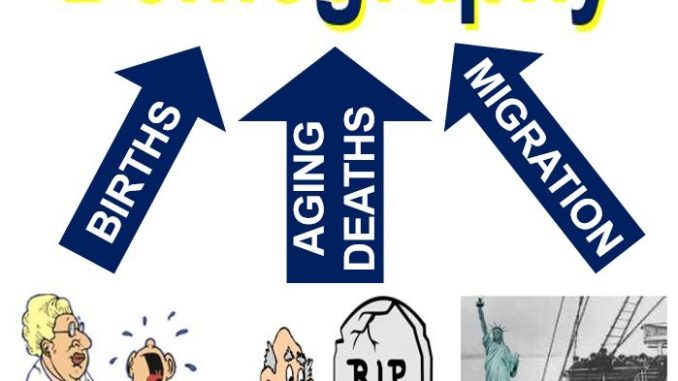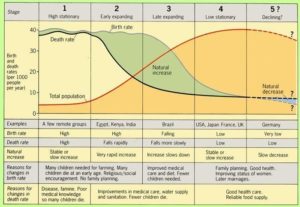
Table of Contents
What is Demography?
- Demography is the scientific study of human populations primarily with respect to their size, their structure and their development
- Demography is the statistical and mathematical study of the size, composition, and spatial distribution of human populations, as well as how these features vary over time
- Demography is defined as the statistical study of people/human population.
- Demography refers to the concepts and methods used to examine human populations
- The word ‘Demography’ is derived from two Greek words: ‘demos’ which means people, and ‘graphy’, which means science.
- The examples of demographic data are employment, education, income, marriage rates, birth and death rates, and other socioeconomic indicators.
Theories of Demography
- Demography is one of the key theoretical concerns in the twentieth century
- It is more of a generalization from observable trends than a theory of descriptive and pedagogic value
- It shows many patterns of transition, with varying time and explanations
- Movement of death and birth rates in a society from a high level (in the pre-transition stage) to a low level (in the post-transition stage).
- The transition period is the period between these two stages, during which the population grows fast as births outnumber deaths
Demographic Transition Theory
Demographic Transition Theory consists of five stages. The detail description of all the five stages is given in the figure below:

Major Demographic Process
- Demographers investigate the three key demographic processes: birth, migration and death to better understand population dynamics
- All three factors influence how people inhabit the globe, build nations and societies, and produce culture
- Births are affected by fertility, death by mortality and migration by the process of migration
- In this way population is related to population growth and mortality to population decrease. Similarly, migration is also related to population due to in and out going migration
- Marriage on the other hand is also responsible to cause population change especially in women
- Therefore, birth, death and migration are the key demographic processes that cause change in the population size, composition and distribution
Sources of Demographic Data
1. Main sources
- Census
- Vital registrations (birth, marriage, death, migration)
- Sample surveys (demographic health surveys, multiple indicator cluster survey)
2. Some other sources
- Population register
- Demographic surveillance systems
- Voters registration
- Social security system
- School enrollment
- Income tax returns
Components/Elements of Demography
1. Size
- The total number of people living in a specific place at a specific period is referred to as population size.
- All factors that influence population size are studied in relation to any field of demography, we can see how important they are in influencing population size and shape
2. Geographical distribution
- Migration has a significant impact on population distribution and labor supply.
- Demography is the study of the causes that cause people to migrate internally and externally within and across countries.
- Another element affecting population distribution within the country is urbanization.
3. Composition
- The study of population composition and density is essential
- Composition of population characteristics such as the sex ratio, race wise and age-group wise population size the ratio of rural to urban population are very important
4. Components of change
- The birth and death rates are the most important determinants of population growth; hence their inclusion in population studies is essential.
- In addition, factors such as marriage and migration are also equally important.
Importance of Demography
1. Economy
- Population studies allow us to see how closely the economy’s growth rate meets the population’s growth rate.
- If the population grows at a greater rate, the economy will develop at a slower pace.
- The government can take necessary measures to restrict population increase and stimulate economic development.
2. Society
- When the population grows rapidly, the society is confronted with numerous issues. Basic utilities such as water, electricity, transportation and communications, public health, and education are all affected
- Problems of migration and urbanization are also linked to the expanding population, resulting in an increase in law and order issues.
- As a result, the government and non-governmental social organizations can take necessary action to address them
3. Economic planning
- Data on the current pattern in population growth aid planners in developing policies for the country’s economic plans.
- They are kept in mind while setting agricultural and industrial product targets, as well as social and fundamental services such as schools and other educational institutions, hospitals, housing, power, transportation, and so on.
- Planners also utilize population data to forecast future fertility patterns and design policy strategies to reduce the birth rate
4. Administration
- Government administrators can benefit from population studies as well.
- Almost all social and economic concerns in underdeveloped countries are linked to population growth.
- The administrator must address and provide answers to the issues that arise as a result of population expansion.
5. Political system
- Demographic knowledge is important for a democratic political system to function.
- The election commission of a country demarcates constituencies based on census numbers pertaining to various locations.
- After each election, the number of voters is increased to see how many people have moved in from other parts of the country.
Tools of Demography/Demographic tools
1. Rate
- The most extensively used comparative population change measures
- Demographic rates, in theory, should depict the relationship between the number of demographic occurrences (numerator) and the population at risk of experiencing them (denominator) over time
2. Ratio
- The magnitude of a number in comparison to another useful number
- Ratio is used when the population at risk is unavailable
- Denominators for ratios are chosen based on the available data and ease of understanding.
- For example, the sex ratio is the number of men per hundred women.
3. Proportion
- A decimal fraction in which the denominator includes the numerator (between 0 and 1)
4. Constant cohort measure
- The aggregate of all units that experience a particular demographic event within a specified time interval is referred to as a cohort.
- The most common cohort is the birth cohort, which refers to people who were born during the same time period.
5. Period measure
- Period data are events that occur over a specific time period, usually one year or five years.
- The demographic experiences of persons of various ages are represented in period data (in other words, people belonging to many different birth cohorts).
- Many commonly used demographic rates, such as crude birth rates, are based on period data.
Application of Demography in Health Science Studies
- Estimation of population health indices (birth rate, death rate, average life expectancy, reproductive final parameters);
- Estimation of population reproduction laws and uniformity of structure;
- Planning, accommodation, and forecasting of public health service staff networks based on population size and structure;
- Estimation of the effectiveness of medical-social planning and forecasting;
- Deep statistical analysis of its health status, medical institution operations, and exact planning of their work.
References and For More Information
https://unstats.un.org/unsd/demographic/meetings/wshops/Myanmar/2014/docs/s05.pdf
https://www.sciencedirect.com/topics/social-sciences/demography
https://www.nationalgeographic.org/encyclopedia/demography/
https://thefactfactor.com/facts/pure_science/biology/demography/1838/
https://www.investopedia.com/terms/d/demographics.asp
http://studylecturenotes.com/importance-of-demography/